25 Galley Gear Essentials (We Used All the Time).

Your galley must be equipped with everything you will need for a life aboard. You already have most of these tools and gadgets at home.
But which ones to take?
Does it matter if you have a monohull vs a catamaran?
With two boats, only solar power and three crew members who love to cook, we went through some trial and error until we ended up with our favorites below.
For more useful boating items – visit our Boat Gear page.
Chopping and Prepping
Anything sharp and good quality goes here. Grab your favorite ones and keep them safe at all times.
Cat or mono does not matter – just decide on the storage method (discussed below).
1. Knives
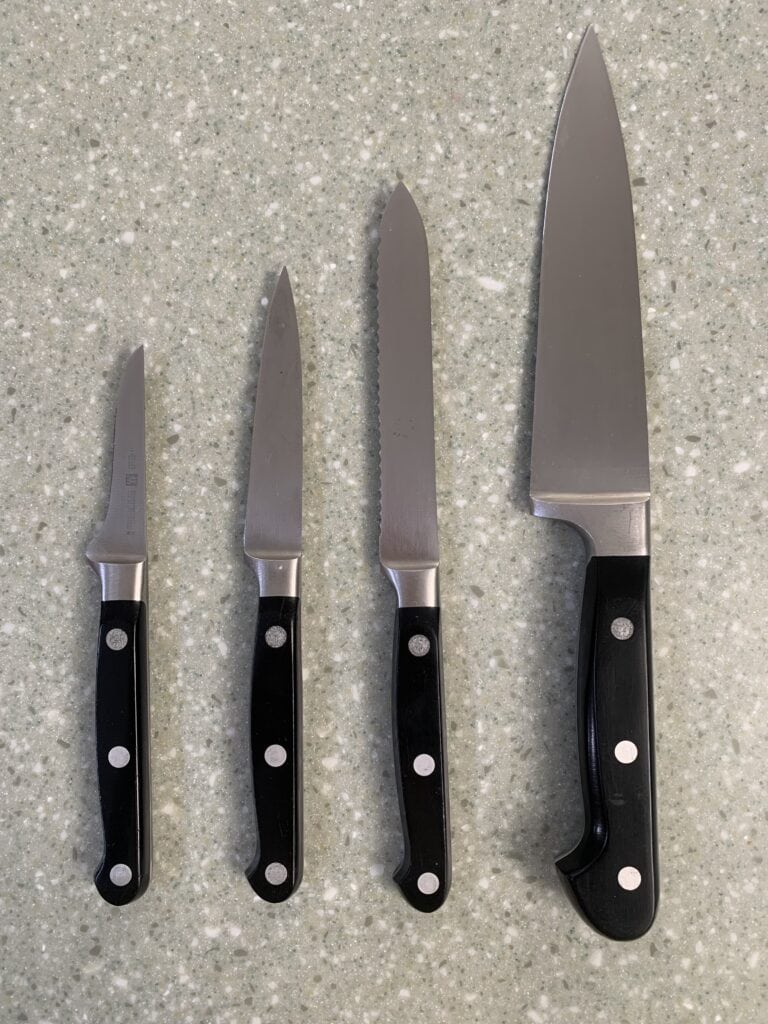
I have been using my Zwilling Henckels knives for 15 years. There were a few expensive utensils, which we left behind, because loosing something in the back yard aboard, might mean it stays there forever.
But I had to take my knives! They are the equivalent of the Captain’s tools – have to have the right ones.
There is a cheaper alternative to the Zwilling, the plain Henckels knives.
To tell them apart – there is only one little person on the logo for the Henckels, instead of two. The Zwilling kind are better (I have tried both, because I bought my parents the cheaper kind as a gift).
Regardless of the brand, make sure they are made of premium stainless steel, or you will end up with rusty knives aboard, not a good situation.
Speaking of rusty, keep bags and clothes with metal zippers off the boat, here are good alternatives:
19 Best Boating Bags. Tips How to Use Them.
9 Sailing Outfits for any Season and Reason
Here is a link to the knives I have.
Tip: Wash and dry immediately after use. This will prevent accidental chipping and rust.
2. Filleting Knife
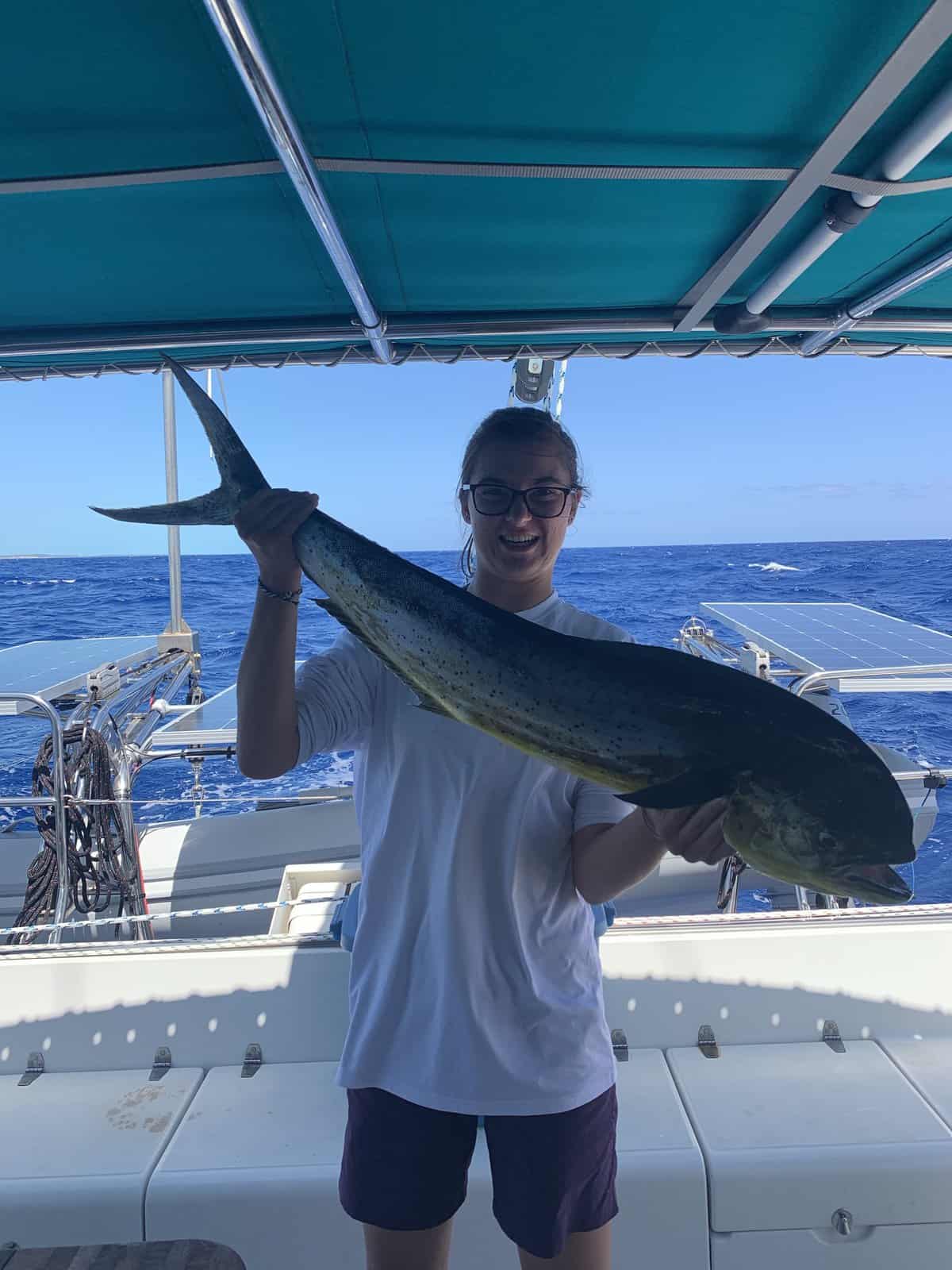
Having never filleted fish, I had no clue what kind of knife to use.
When a friend of ours gave us three fishes as a gift, I grabbed my large chef’s knife and headed off to clean the fish.
Thankfully, he stopped me on time! What a difference a good filleting knife can make!
You need a very sharp, long and skinny knife, to be able to feel the bone, while cutting around it. I received my knife as a birthday gift.
Note: There are probably better and more expensive ones out there, but mine does the job and I’d rather invest in fishing gear!
3. Knives Sharpening Tool
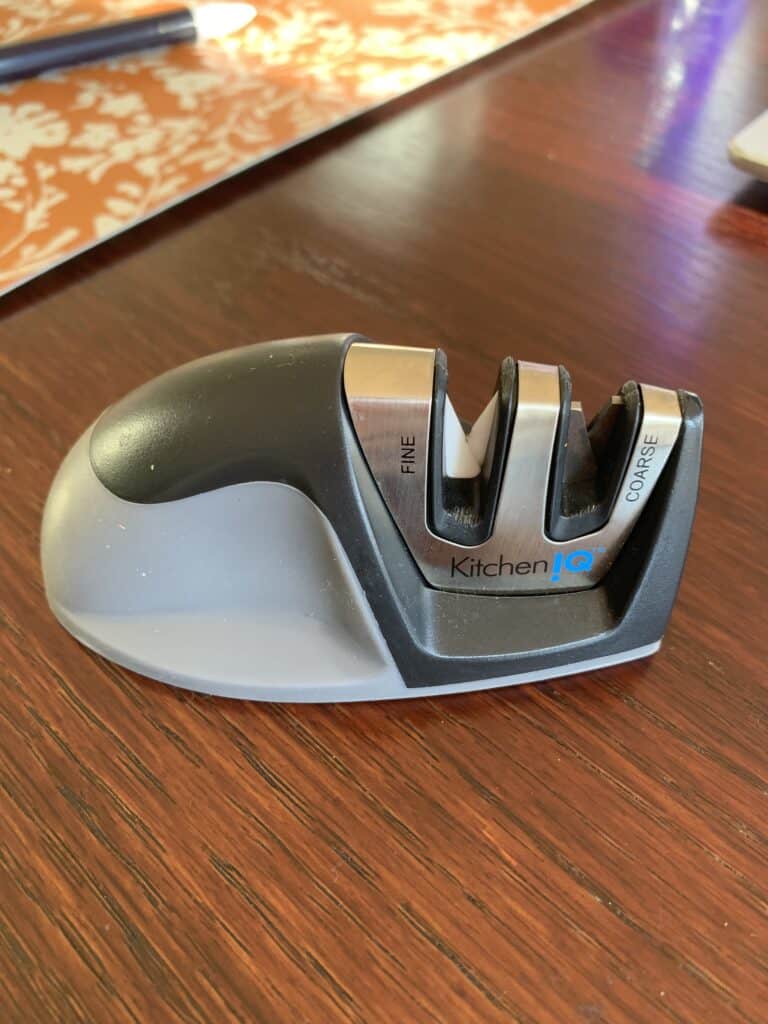
Dull knives are very dangerous and annoying!
We found this sharpener and never looked back. It is perfect for life aboard.
It is small (like, 10 bonus points right there), light and easy to take along for extended travels.
I do like the original sharpening tool, which came with my Henckels knives, but it is too big. After a bit of use aboard, we found the one I am recommending and put the bigger one in storage.
Tip: Take it with you when you are traveling and staying in Airbnb’s, their knives are notoriously dull.
4. Knives magnetic strip
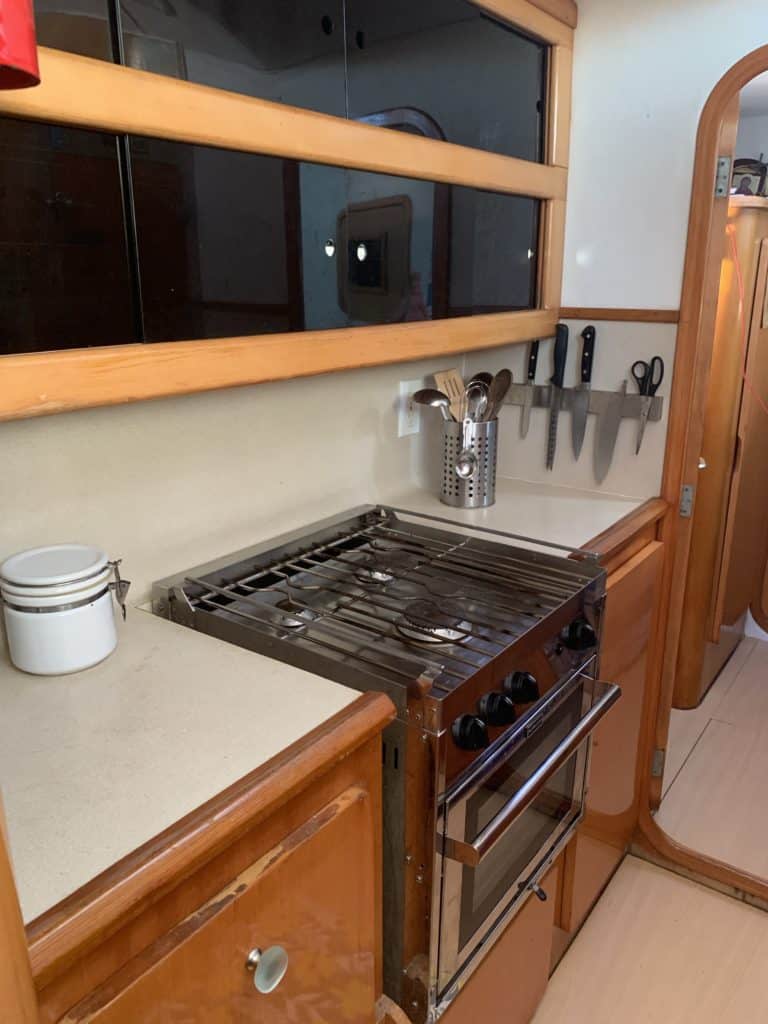
The great wooden block – leave it at home.
It does not work on any boat, including a catamaran. It takes up too much counter space, and it will tip over during a rough passage (especially on a monohull).
Storing quality knives stacked up in a drawer is completely out of the question, don’t get me started.
Storing each knife in its own case is inconvenient and, again, takes up precious drawer space.
I love being able to reach for the knife when I need it, so we bought the one I am linking to below. It is plenty strong to hold the knives during a rough passage.
Tip: Remember to dry the knives before putting on the holder, to avoid rust.
5. Everyday Cutting Boards
I love wooden boards.
And yes, you can use wooden boards aboard. Just keep them clean and dry (like everything else).
Here is a link to a solid wood cutting board, which is excellent for humid environment.
Tip: Have a multi-purpose board. I had a large wooden pizza board, which served as pie rolling board, pizza board and bread board.
6. Cutting Board for fish
You must have a designated fish cleaning and fileting board.
It must be plastic.
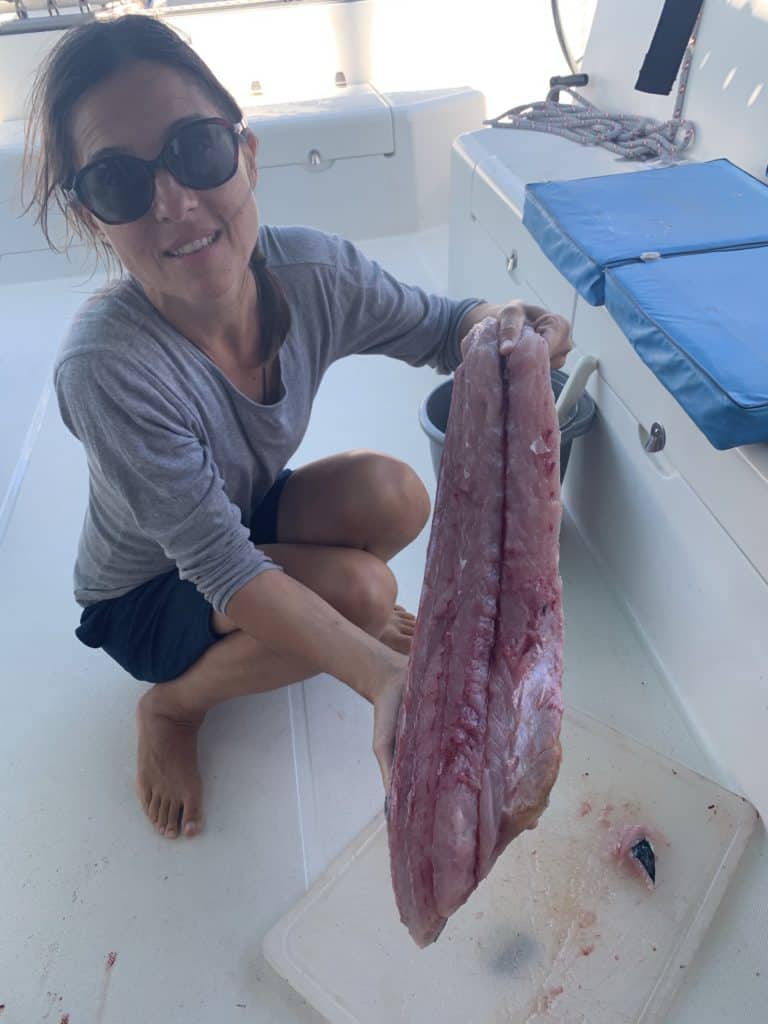
Once you start cleaning your catch, the board will smell like fish.
Forever.
When shopping around, look for a very large board (as in cannot-fit-in-any-cabinet large). The ocean fish you will catch are not small. At all.
This will make a great gift for a boater too.
Here is a link to one similar to what we had aboard (ours came with the boat). The one at West Marine is bigger.
Tip: Store it somewhere outside and clean your fish outside as well.
7. Fish Cleaning Station
If your boat allows it, buy a fish cleaning station.
They can be attached to the boat in various ways, so just check what kind might be suitable for you.
You will most likely be cleaning the fish while sailing, so make sure you have a spot, which is comfortable and protected.
I was always in a semi panic mode, while Joe was handling fish on the transom, while sailing. Don’t do that. And, please, wear a life jacket (you owe her that much).
I cleaned our catch on the floor of the cockpit. Right next to a drain.
Here is a link to a fish cleaning station. The Amazon one is smaller.
Tip: It is always better to clean your fish while still out, otherwise you will attract sharks at your anchorage. And there goes the afternoon plunge.
8. Cheese Grater
Going back inside the galley – you will need a cheese grater.
It must be sharp and flat. That’s all.
There is nothing special about picking the right cheese grater. Opt for one with medium size holes, so you can grate cheese, as well as nutmeg and orange zest.
Here is a link to something, which will work well aboard.
9. Can opener
Manual can opener, which does not take space is ideal.
Ours was a gift and it cut the top of the can in way that made it replaceable, as a can lid – genius!
We used it all the time – you will have all kinds of stored canned goodies aboard, and they are very handy to prep a quick meal and go swimming.
Cooking Vessels
Always match the cooking gear to the space you have. Measure before you bring things aboard.
For tips how to store yummy food aboard:
Storing and Organizing Food Aboard – You Can Beat Heat, Moisture and Motion!
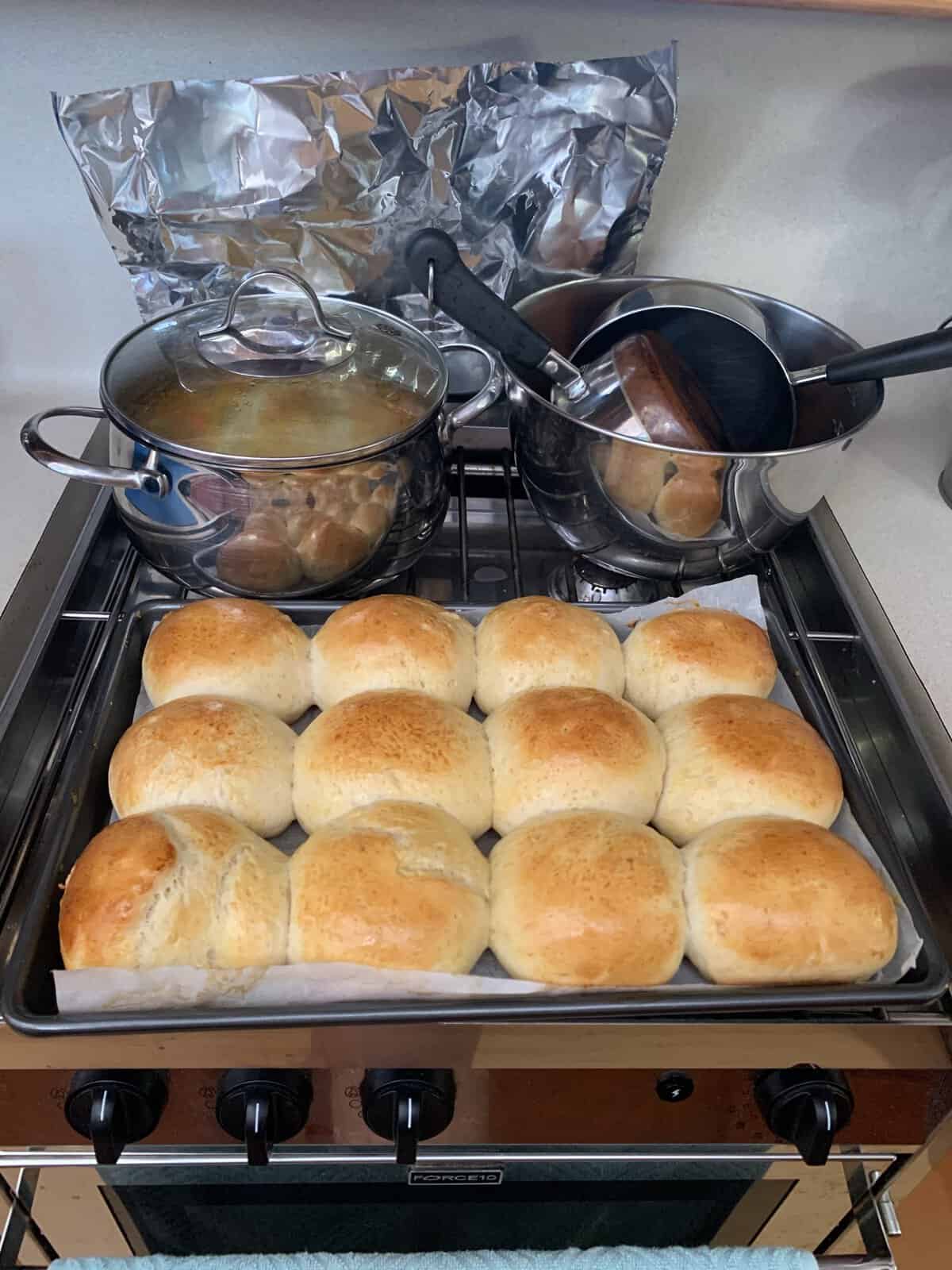
It is more important to fit everything perfectly and snuggly on a monohull, because things do fall out and break during passages.
10. Regular Pots
Whatever your favorite pots are on land – bring them aboard.
Make sure they can be stored nestled inside each other.
Since you will most likely be cooking on a gas stove, select pots with very heavy bottom, otherwise they will bend after some use over an open fire.
Here is a link to some of my favorite kind, I used them all the time.
The links are to sets, just to give you an idea of the options.
Tip: Four pots of various size are all you need. I fed five adults aboard.
11. Lobster pot
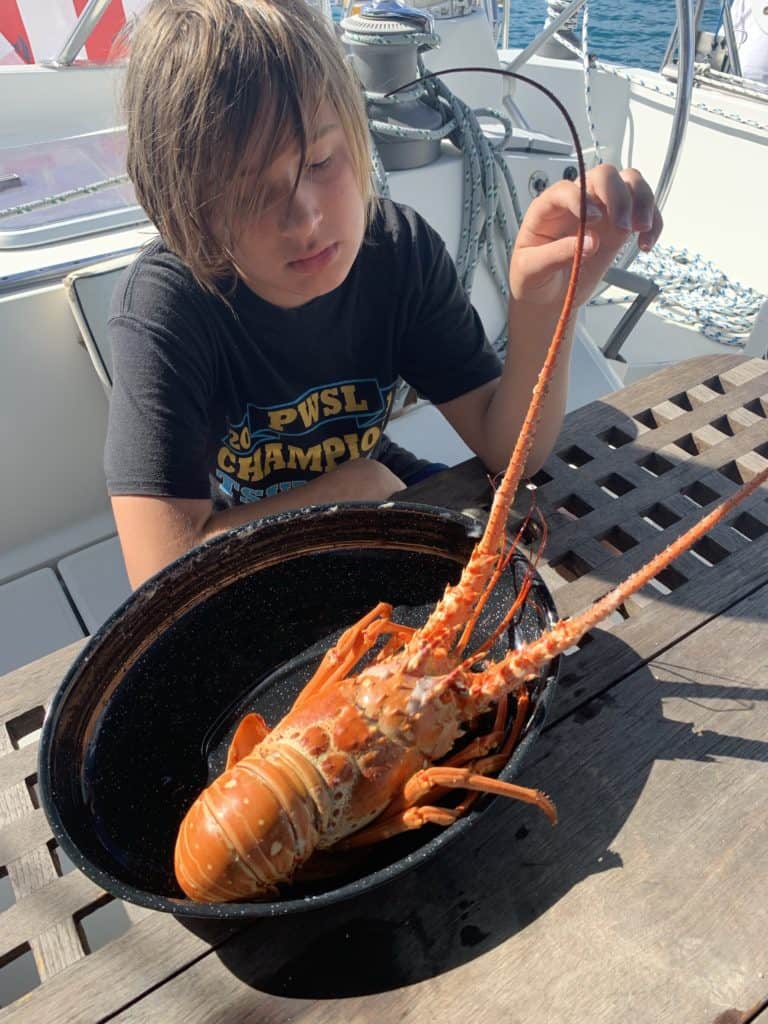
If you like lobster, you will catch some. It is a given.
So, once you have the lobster, you need a place to cook it.
I had one of those large oval dark pots from Walmart, which are used for boiling canning jars.
Multipurpose is a must aboard (I might have mentioned this already 😉
Here is what we had aboard.
Tip: Since the pot is very large, use it for storage. Then just remove the items temporarily to boil the lobster.
12. Frying pan
I hate frying aboard.
The entire boat smells like oil. Even with the special fan that Joe put in.
But, we love crepes, pancakes and quesadillas.
And toast!
Since there is no room (or electricity) for a toaster aboard, leave that behind and use a larger pan for toasting bread. Spread some butter, or olive oil on the bottom and the toasts taste out of this world.
I had a large non-stick pan. Similar to this one:
Tip: Since you will end up stacking other pots and pans on top of that one, slip it in a pillowcase to prevent scratching.
13. Cast iron pan
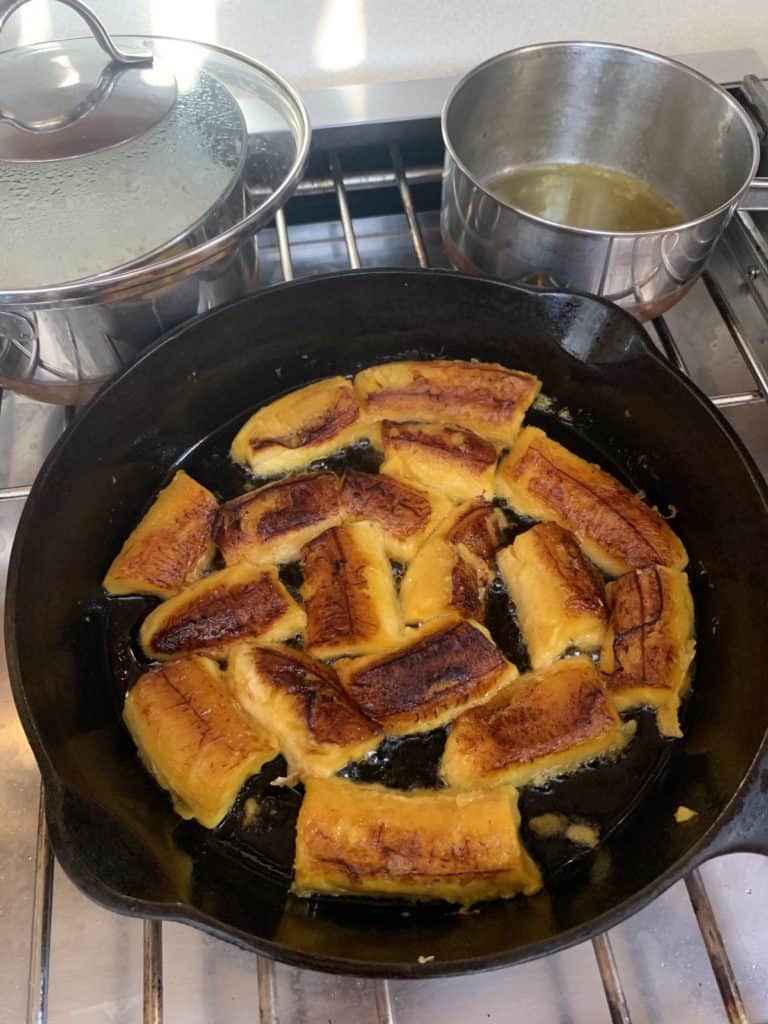
It is a natural source of iron, and naturally non-stick.
I used it all the time and stored in the lowest possible cabinet. It is heavy, but I loved it.
You can purchase a cast iron pan in many stores, including on Amazon. I am not sure which ones are the best, but as far as I am concerned, if it is iron, it is iron.
It DOES make a difference that it comes with a lid. Otherwise your boat will be a small, steaming oven.
I also love the handle holder, because with cast iron – every surface is a cooking surface.
The last thing you need if dealing with burns, instead of enjoying your time in the Bahamas!
I have never used any special oils for seasoning cast iron, so I cannot tell you how well they work. I always use coconut oil, or any oil sitting around. Just make sure it is not a lot.
TIP – once scrubbed and washed, heat up on the stove for a bit, then rub with a tiny bit of any oil before storing. It will prevent it from rusting and is the proper way to store cast iron.
14. Yoghurt jars
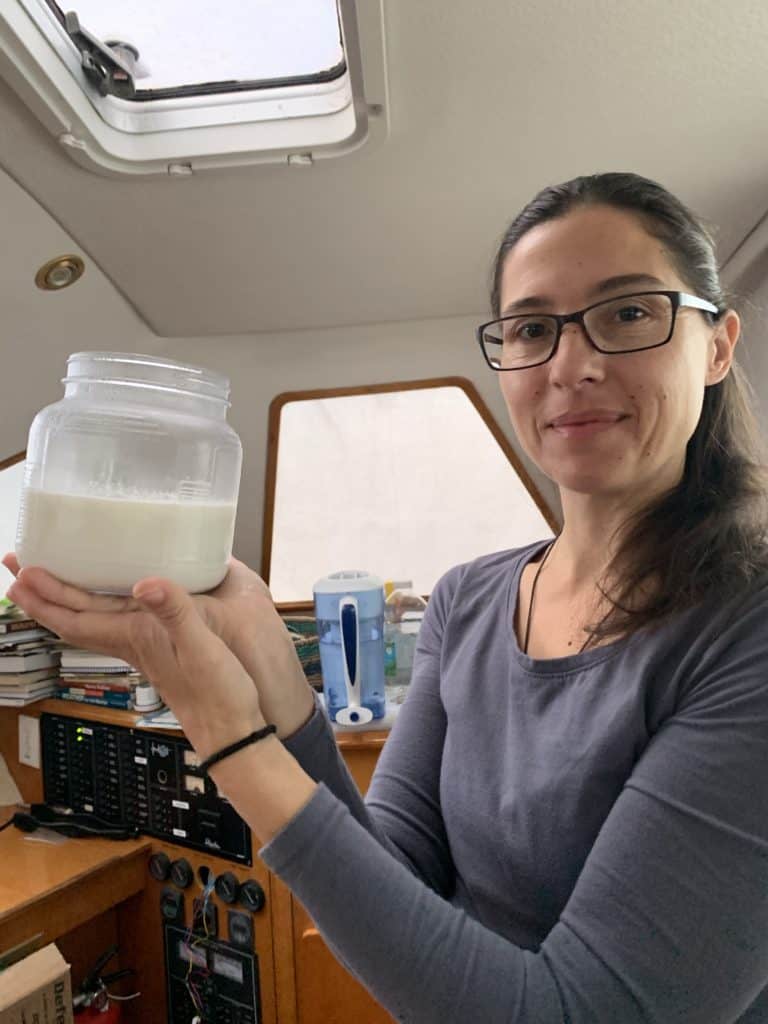
I have made yoghurt for years. And I am very good at it.
And, yes, I do have a secret.
And I don’t mind sharing it, it’s in this post:
How to make yoghurt, with a story!
Having said that, I think all the fancy yoghurt-making jars and pots are a waste of money, take up space and are hard to wash.
Grab regular, larger jars and use these instead. The post I shared above has my yoghurt recipe, which has successfully worked for years and is very forgiving.
Here is a link to some great yoghurt jars, which you can slip inside wool socks.
Tip: One liter is the classic size, but you can get a larger one and not fill all the way up. Save some of the yoghurt for next batch!
Electric and Power Gadgets
With limited electricity aboard, we left tons of gadgets behind. Never needed and missed any.
Curious about other gadgets aboard? 13 Gadgets for Boaters
In fact, when we returned to land, I still only used my hand-held blender for every mixing and blending recipe.
15. Immersion blender

Anything larger than a hand-held blender uses too much electricity and takes up space.
I used the hand-held blender all the time – soups, sauces, smoothies, dips… So, when I was shopping for a blender, I needed something strong and reliable.
To be honest, I had no idea which one to buy, after my house blender broke (a popular American brand). I knew I did not want one of those any longer.
When I found the blender on Amazon, I thought I would give it a try. I am glad I did. I never used any of the attachments.
We have had it for four years now, and I use it almost every day!
TIP – Save a couple of 32oz yoghurt containers, with lids, for blending. Once the hummus/sauce/dip is ready, just put on the lid and store in the fridge.
16. Solar Oven
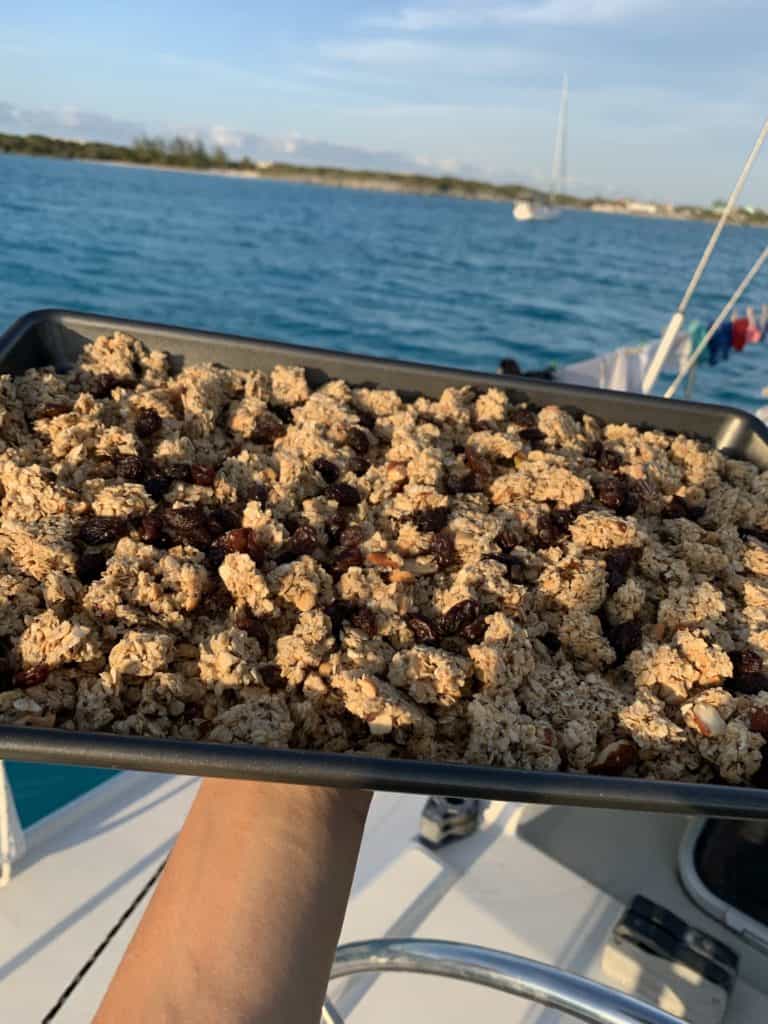
Let me tell you about my solar oven…
It never worked aboard.
The problem with boats, is that they are always in the wind, when on anchor.
It was impossible to get that thing to heat up enough to bake anything different than granola.
In all fairness, I did buy the cheapest one on Amazon and with great reviews. I think it was the environment, which made it difficult to work with.
Fellow boaters swore by the kind I am linking to below:
Note: Here is a link to mine. Let me know if you can make it work aboard.
17. Free-standing freezer
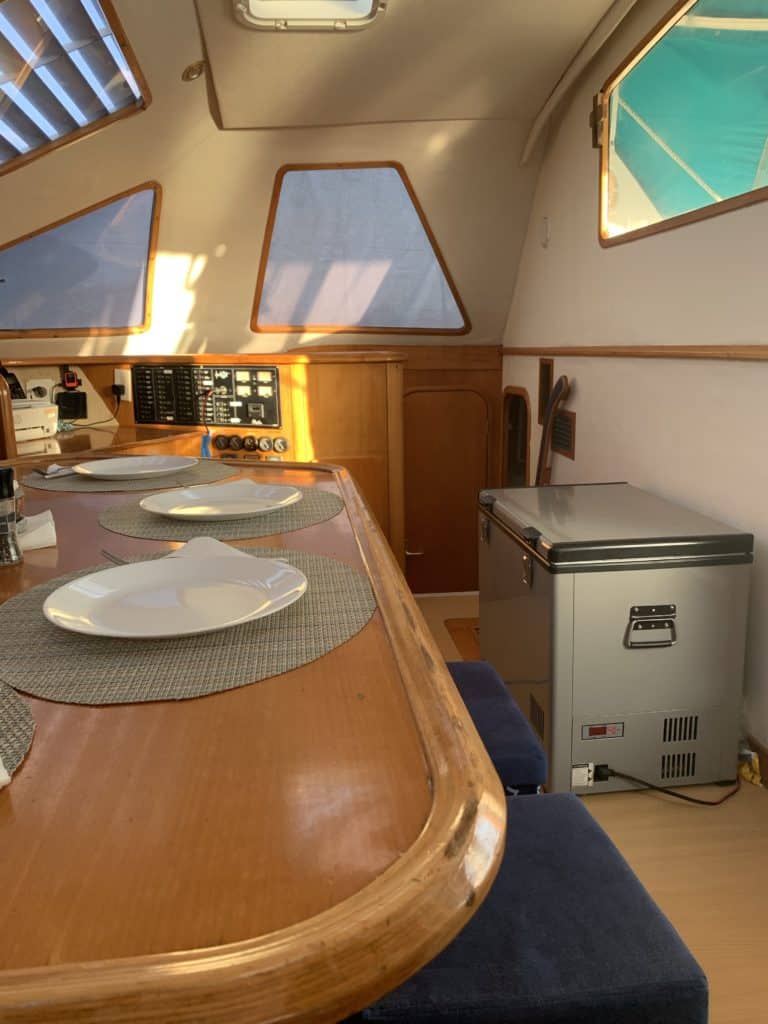
I searched for a free-standing freezer for a long time and read all kinds of reviews online.
And, I have an entire post dedicated to our free-standing freezer aboard. Because I loved it that much:
Affordable Freezer Aboard (Because Ice Cream Matters).
Here is a link to purchase the one we have, on Amazon. You can use it as a fridge, a freezer, or a chest to store dry foods, if you must leave the boat for a while.
Baking and Mixing
For baking, you will want a variety of mixing bowls.
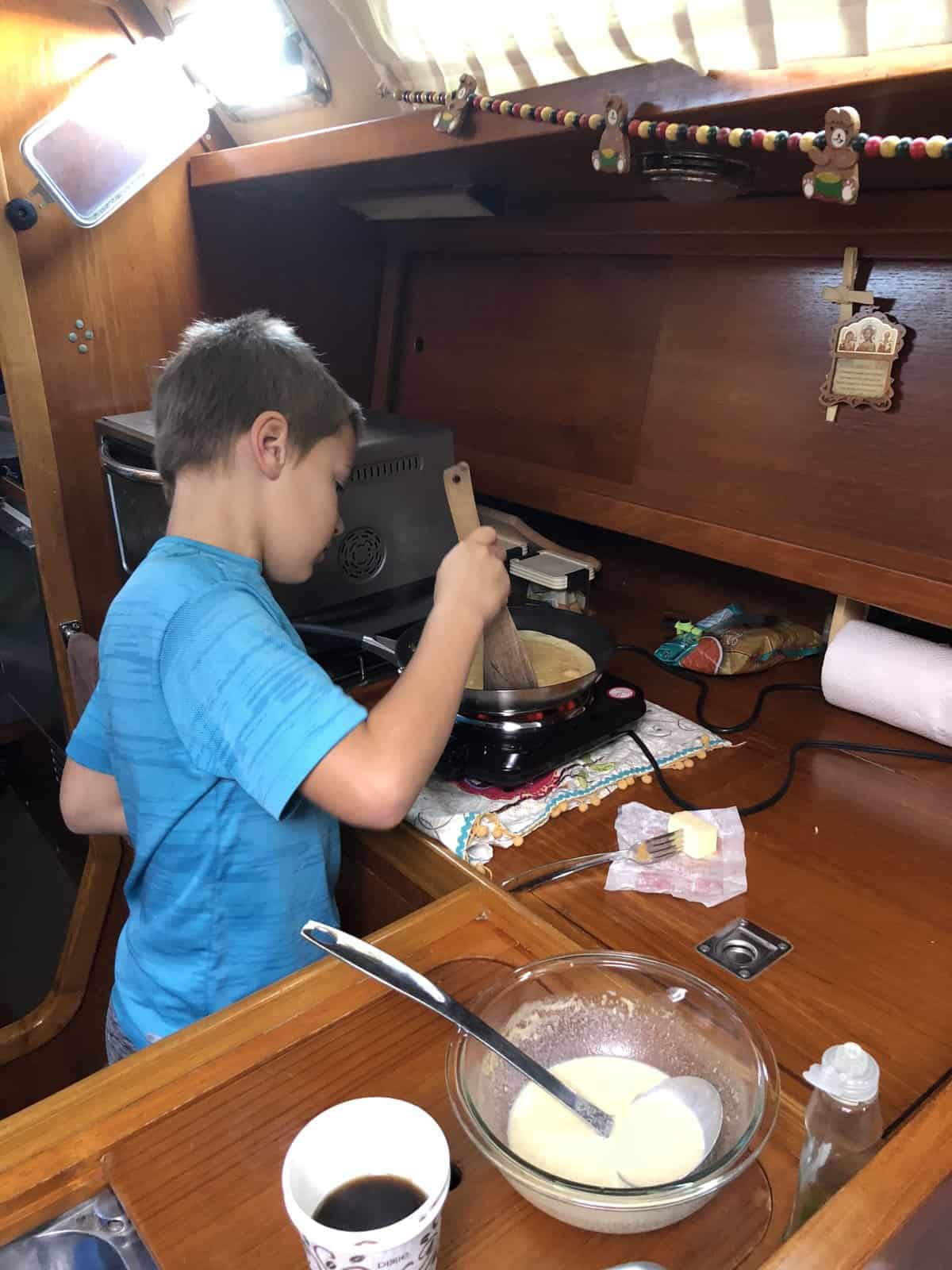
18. Mixing Bowls
Any kind will do.
Since I am not a fan of plastic, mine were all metal.
As long as they are the nesting kind, it really does not matter which ones you have.
Here is a set, which should work well. I just took along mine, from home.
19. Baking pan
Measure your oven and buy the largest pan, which will fit inside.
Forget loaf and bundt pans.
As much as I love these on land, you will waste a large amount of propane to bake a small amount of pastry. Not worth it.
Same goes for muffin pans. Just bake one large pan of pastry and cut it into squares.
The thinner the spread in the pan, the faster it will bake.
Here are a couple suggestions. Just measure your oven first.
Baking a large pizza? Cut it in half and fit the two halves inside, at an angle.
Coffee and Tea
I love coffee.
Joe hates coffee.
We had to have a coffee maker of some sort aboard. And one, which would double as a teapot as well.
20. Stainless steel French coffee press
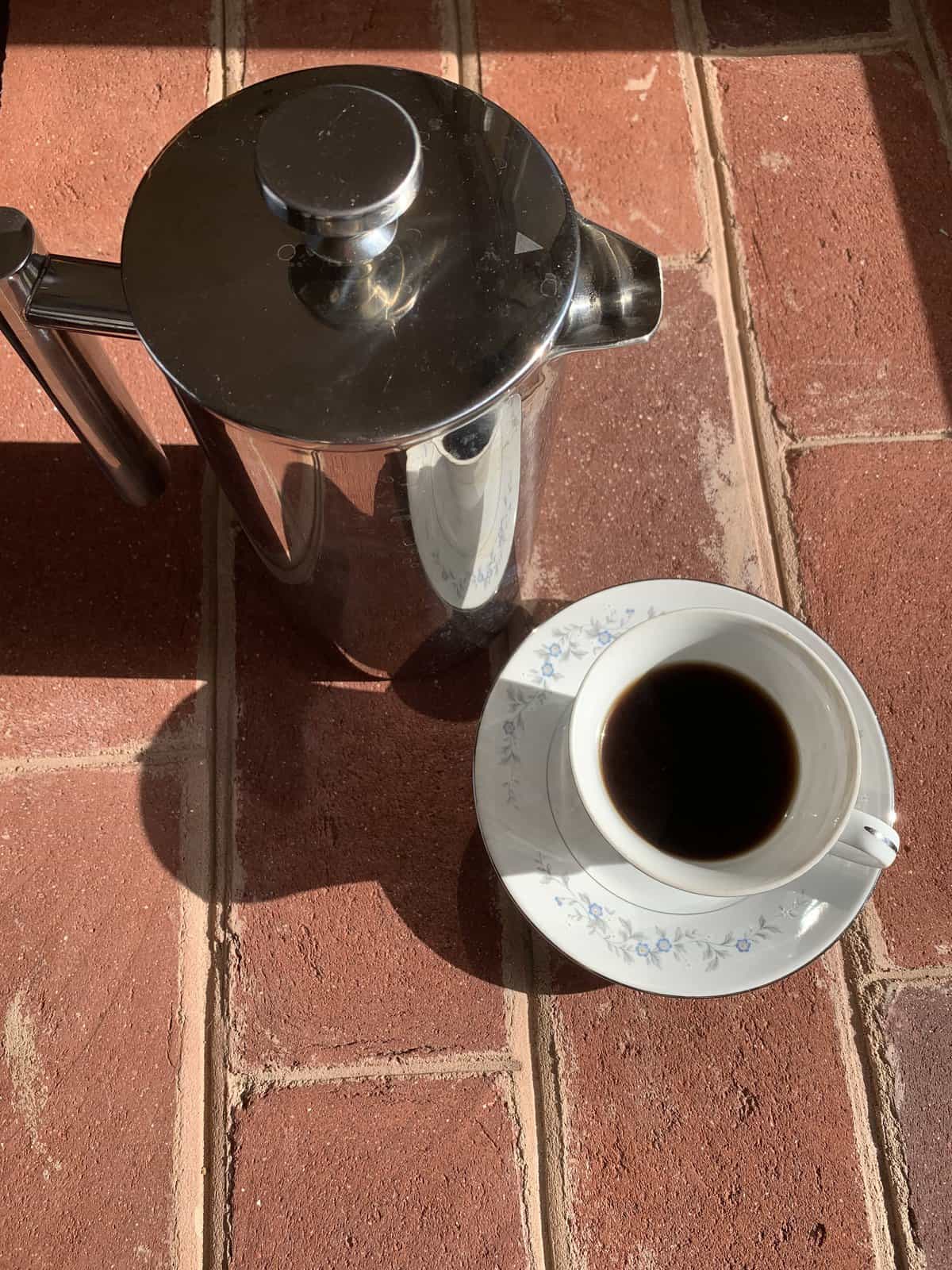
Bringing a standard coffee maker aboard was never an option, because they make terrible coffee.
I am a bit of a coffee snob, I drink mine black, hot and I love the taste.
Since I cannot stand plastic in my kitchen, I decided to buy a glass French press.
It broke.
I bought another glass French press.
It also broke.
After breaking two glass French press containers, I ordered this one and never looked back!
I use both filters stacked, because I don’t like grains in my coffee. The press keeps the coffee hot longer, because of the thick walls.
Naturally, this blog would be a disaster without good coffee!
Here is a link to order what I have and still use on land, every day:
Tip: The French press is a perfect tea strainer too, for any kind of loose tea. Either wash well after coffee, or buy a separate one just for tea.
21 Tea Kettle
Buy one with a whistling spout.
You do not want to forget about that water on the stove. Fire must be treated with great care aboard.
Oh, buy a fire extinguisher for the galley.
Any tea kettle will do, here is one:
Tip: Use the kettle to heat up water for a hot shower aboard.
Serving
Leave your nice plates and cups at home. Take along what you will not be sad to lose, or leave behind.
Avoid plastic, there is no need for it.
Plastic is terrible aboard, because it floats. Away! Glass, metal and porcelain dishes sink to the bottom and are easy to retrieve. Even on the following day.
Avoid disposables, you are not at a kid’s birthday party.
22. Dishes
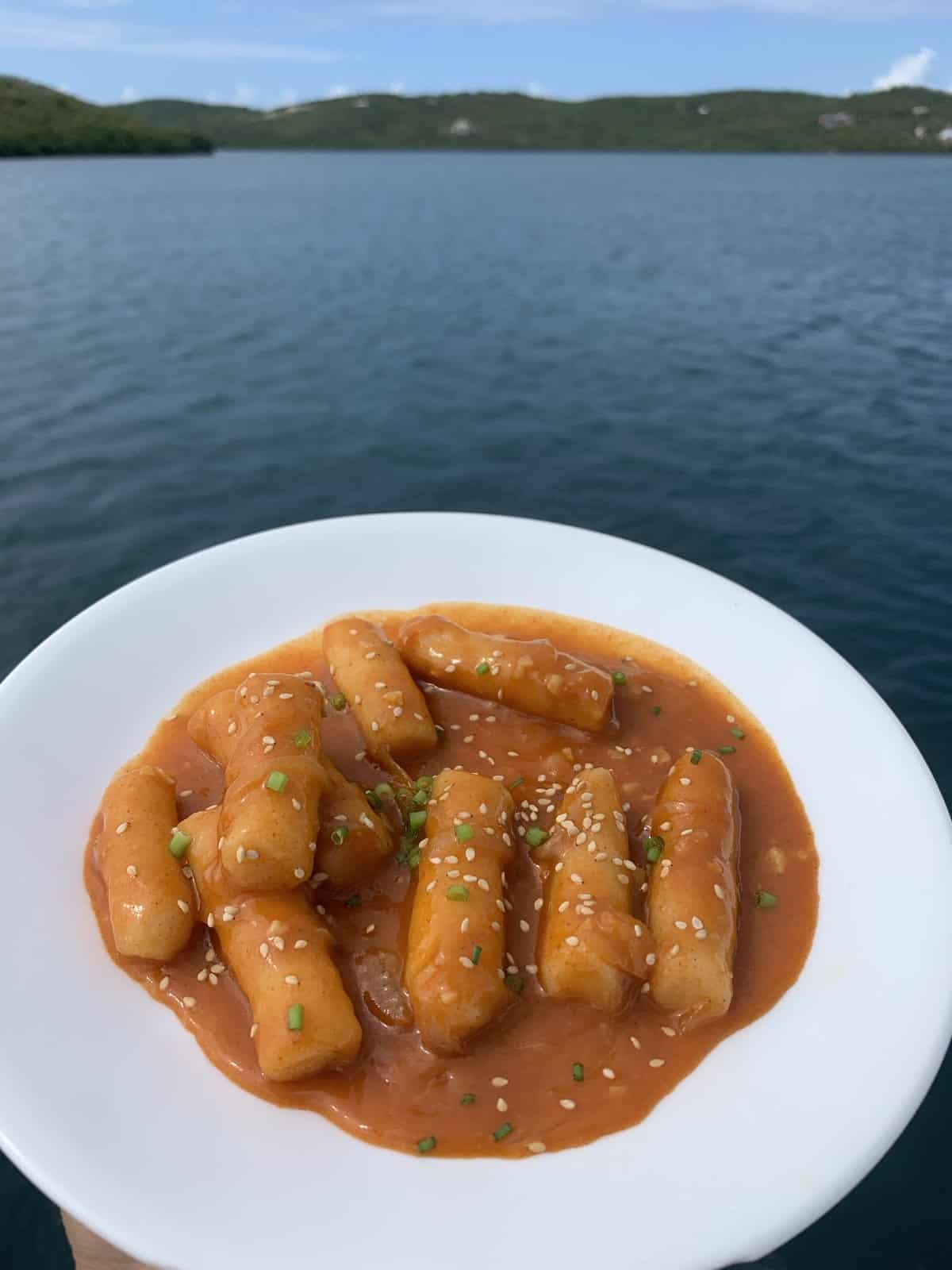
We had both Corelle and regular, porcelain dishes.
Corelle dishes take up less space.
They are known to be difficult to break, but any dish is not easy to break aboard, because most surfaces are soft.
No boat that I know of has granite counter tops, or ceramic sinks, so dishes tend to not break, regardless of material.
Having said that, we did break a Corelle in the cockpit once and those tiny shards lived with us for weeks after.
We dropped countless dishes overboard. As we rinsed our dishes off the boat, to conserve fresh water, an occasional dish or bowl would sink to the bottom every week.
Thankfully, tropical waters are very clear, so the dish duty for the kids was accompanied with a dive duty to retrieve items from our “back yard”.
Kind of cool.
Tip: Measure the space aboard, where the plates will live and then figure out what to bring.
23. Cups
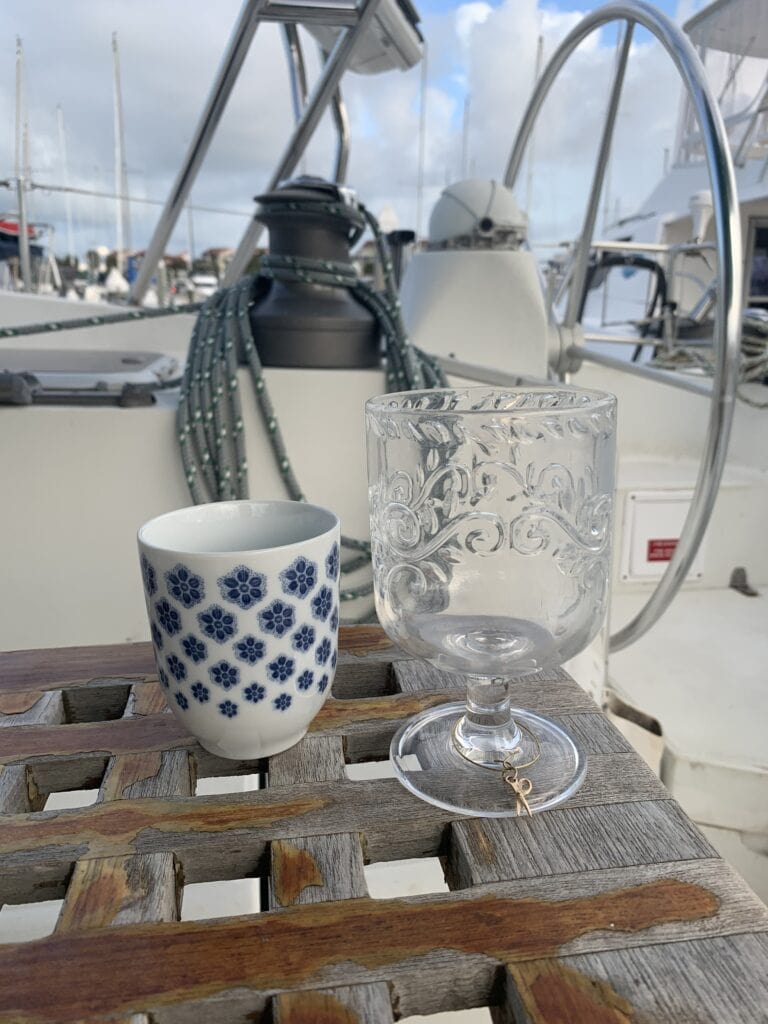
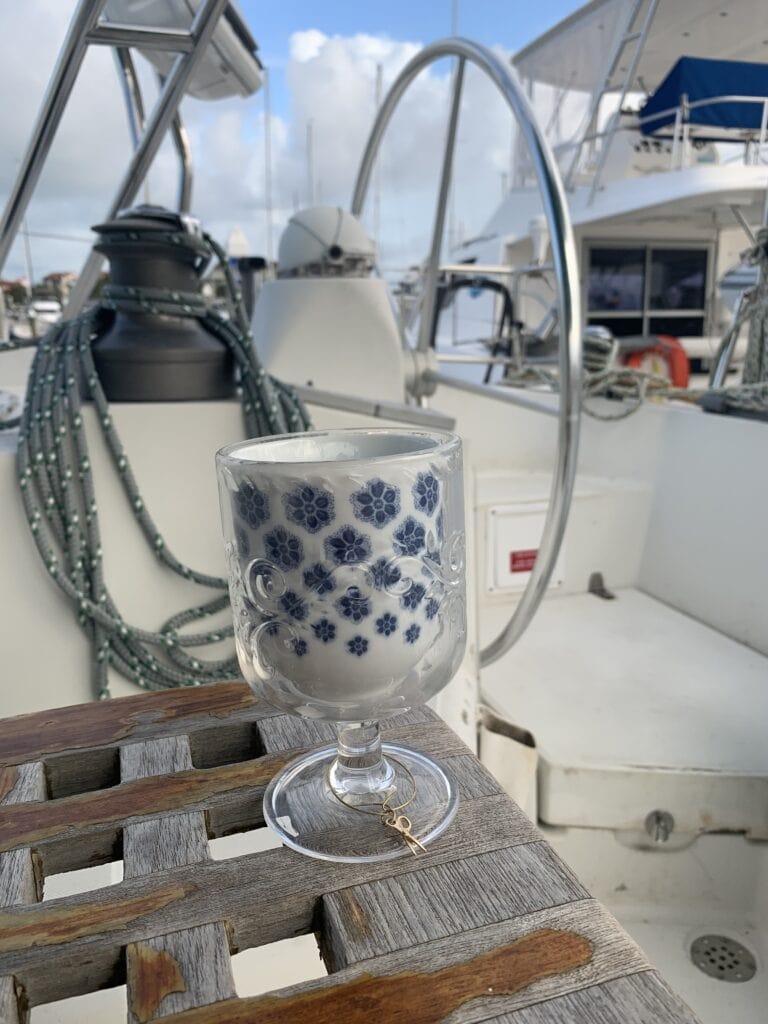
We had a few plastic cups, which came as a present. While we occasionally used them, their purpose was to protect others.
Here are some tips for selecting cups aboard:
- Buy mugs without handles, for easy nesting into plastic cups.
- Go stemless for wine glasses, for better stability.
- Measure the cabinet height, boat cabinets are short.
- Keep a stack of colorful plastic cups for guests.
- Stainless steel tumblers will last the longest.
I am including a link to the boater’s favorite Yeti tumbler – everyone has at least one.
Tip: It is common knowledge that when visiting other boats, you arrive with your own cup, so having some with a lid helps.
24. Utensils
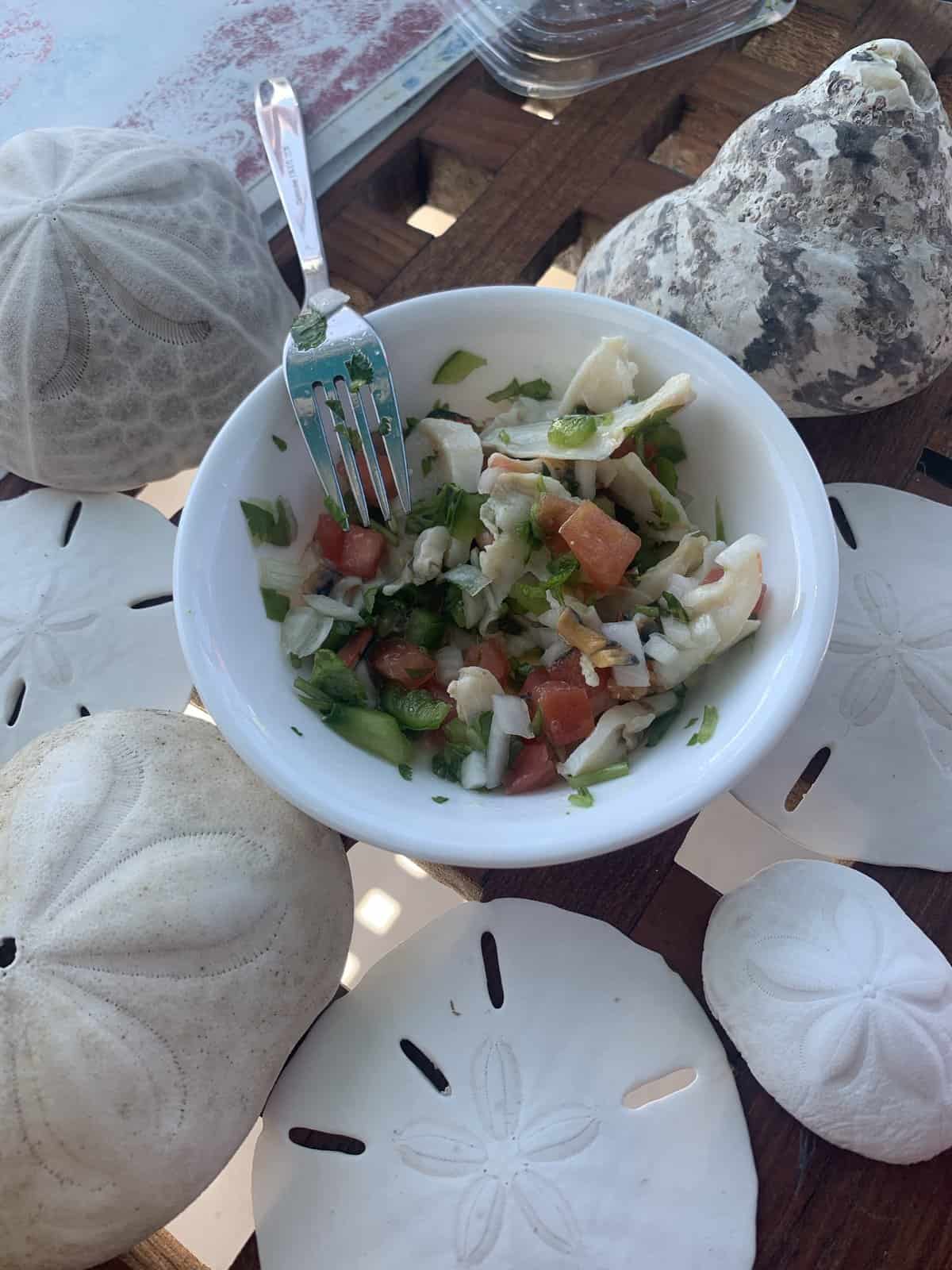
Anything goes here.
Except for plastic, of course.
Leave your nice set of utensils at home and just buy a new set for the boat. Anything you will not be upset to lose or leave behind.
We dropped quite a few forks and spoons overboard and I sometimes found out at the next anchorage…
I prefer the utensils to be heavy enough and sink, rather than float away. Anchorages are typically shallow enough.
Here is a link to a basic set:
Clean-up
Dishwashers do not belong on boats. Some do have them, but they are probably not the ones reading my blog.
So, doing dishes by hand is a given aboard.
25. Drying rack
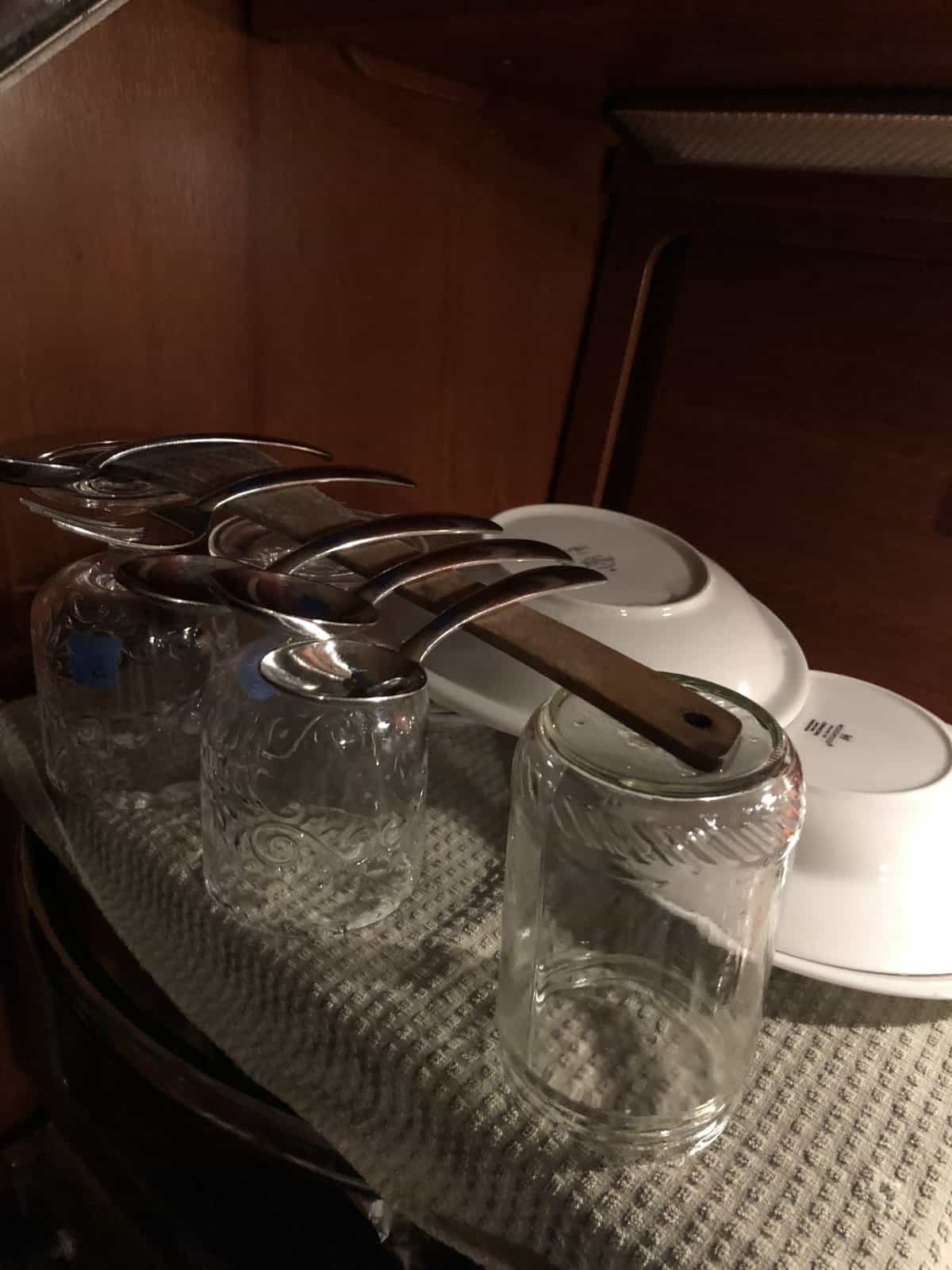
A folding drying rack would be perfect aboard, so you can easily put it away.
We had a drying rack, which we placed on top of a dish towel.
You can also keep the drying rack outside, in a covered cockpit, to save countertop space.
Here is a link to a foldable drying rack, perfect for a boat:
Easy clean-up Tips:
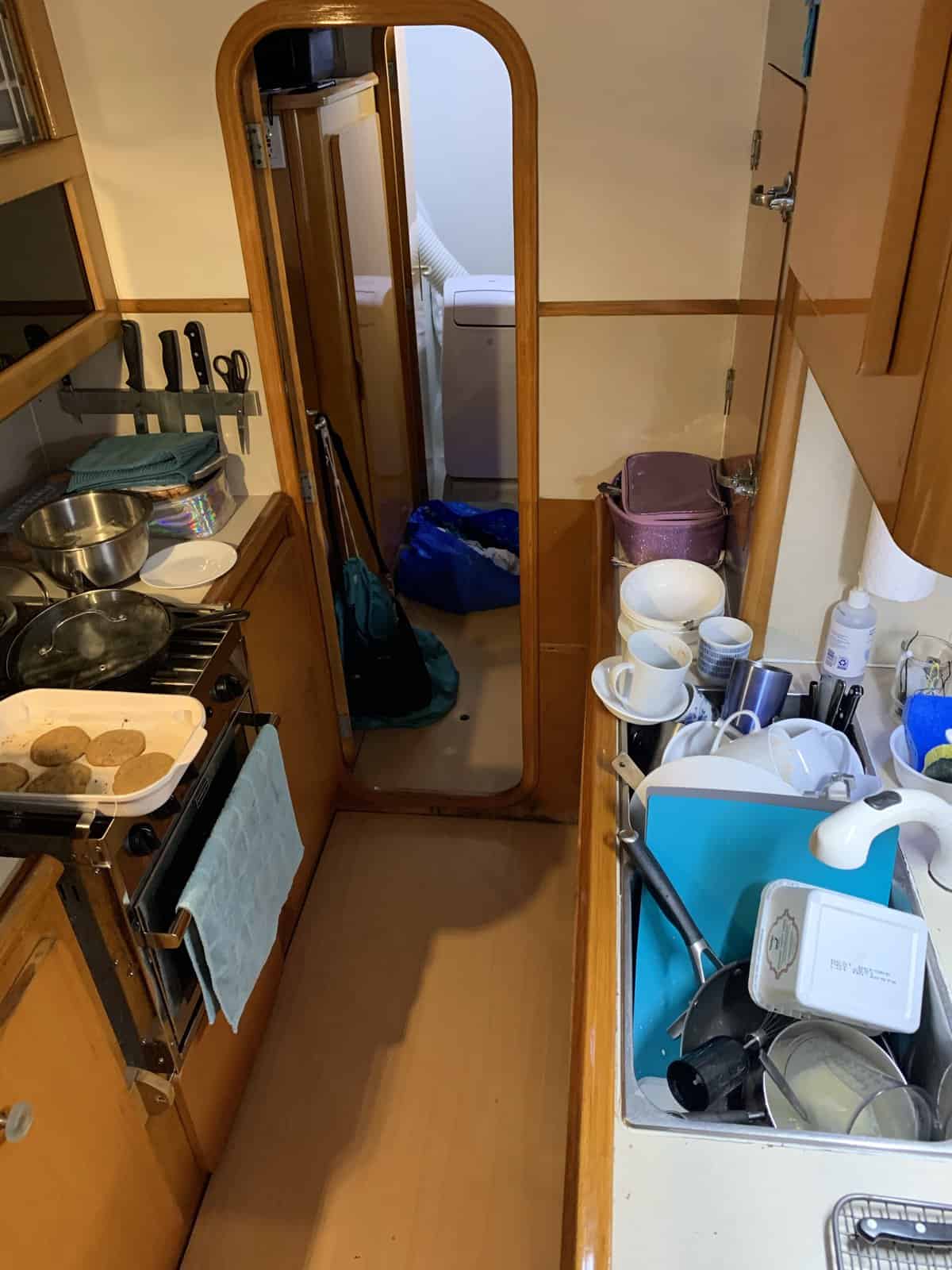
Your galley will moslt likely look like that, at least occasionally.
- Rinse dishes overboard. Conserve water.
- You can use clean salty water to rinse dishes from the soap.
- Rinse with fresh water over a plastic container. Use it to soak dirty dishes.
- No double sink? Get a plastic container and put inside, or by the side of the sink.
- Assign dish duty to the kids.
Storage
There will be a separate post of storage aboard.
Oh, and here is one about storing food aboard:
Storing and Organizing Food Aboard – You Can Beat Heat, Moisture and Motion!
And we did use lots of bags too, so:
19 Best Boating Bags. Tips How to Use Them.
Until then keep these tips in mind:
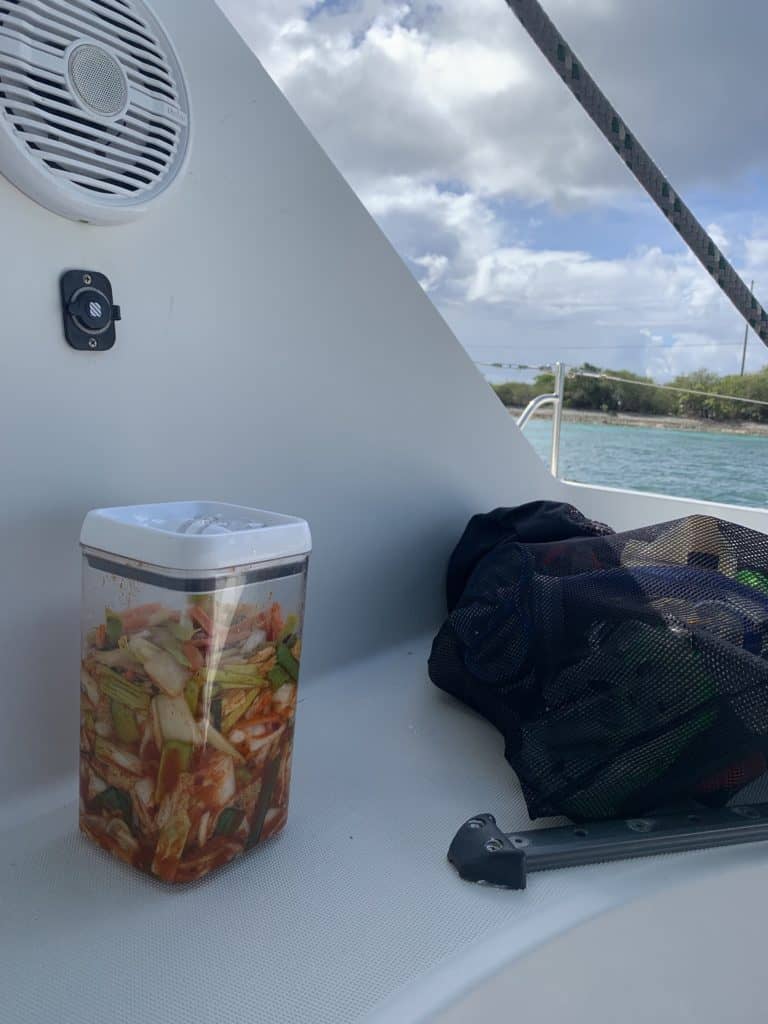
- Buy some stackable airtight containers. Clear plastic work best.
- Grab a few extra large Zip-lock bags, for flour, grains, fish filets.
- Insert a silica bag in the container with anything you need to keep dry.
- Slip glass jars into socks (you stack up two in a long sock.
- Store things very close together. Passages can be rocky.
- Use pillow cases to protect non-stick pans and casseroles.
- Buy a spare set of plastic lids, for any Pyrex containers.
- Use waxed reusable wrap instead of cling wrap.
To Summarize
Don’t overthink it.
Even though it will not earn me any commission, buying anything for the galley is perfectly possible in all other countries (just make sure the voltage is the same).
For the most part, other countries are much cheaper than the US.
If cruising the Bahamas, get everything in the US – things are ridiculously overpriced in the Bahamas (for tourists).
Am I forgetting anything? E-mail me and let me know what else you want covered.
More Boat Gear
Boat Gear – everything on one page.
19 Best Boating Bags. Tips How to Use Them.
9 Sailing Outfits for any Season and Reason
12 Safety Gear Essentials for the High Seas.
First Aid Kit Aboard – Supplies and Organization
Comfortable Sailing Shoes for Every Boating Need
10 Most Reliable Sailing Life Jackets (Adults and Kids)
27 Important Tools for Boaters
51 Classic Gifts for Boaters (Cruisers Approved)
